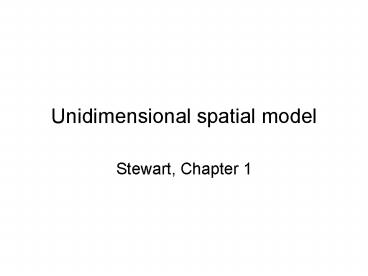Unidimensional spatial model PowerPoint PPT Presentation
Title: Unidimensional spatial model
1
Unidimensional spatial model
- Stewart, Chapter 1
2
Plan of presentation
- Why do we care about theory or explanation at
all? - History of studying Congress
- Politics of Lineland
3
I.Why do we care about theory or explanation at
all?
- Thats what social scientists do
- Thats what politicians do
- Thats what citizens do
- Think about the current campaign and ideological
polarization
4
Different professions have different ways of
theorizing about legislatures
- Activists good guys and bad guys
- Reporters individual stories about good guys
and bad guys - Political scientists The general, generic, and
predictable
5
II.Brief history of political science
- Early days 1880 formalism
- 1900 to 1950 Progressivism
- 1950-1980 Sociology
- 1980 to present Economics
6
What are they?
- Formalism understand Congress by the written
rules. - Progressivism understand Congress by comparing
to normative standards - Sociology
- The group is what is important
- Congress is a group, made up of other groups
- Economics
- The individual is what is important
- Collective behavior derives from individual
interests, preferences, and behaviors
7
Congress and intelligence reform
- Formalist
- What does the Constitution say about the role of
Congress and the Executive in intelligence? - Progressive
- Does the Constitution actually govern the
exercise of intelligence? - Is intelligence gathering a war making power?
- Sociology
- Who are the actors? What (social) roles do they
play? - What factors constrain the actors to stay within
their roles (e.g. what is the committee
environment)? - Economics
- Who are the relevant actors, what are their goals
(election, power, policy) - What are the strategic moves that the individuals
make in order to optimize over the policy space?
8
Advancements in legislative studies
- Our understanding of legislatures has become more
precise over time - Modern legislative analysis focuses on the
interaction between individuals and institutions - Without institutions, decision making is chaotic
- Heritability problem
- Theoretical primitives
- Preferences
- Rules
9
Logic of this style of analysis
- Begin with simple preferences
- How does decisionmakingproceed without
institutions? - How does decisionmakingproceed withinstitution?
- Add complexity and stir
10
The politics of lineland
- Think of the world as a single dimensional policy
space - Harold Hotellings grocery store problem
- Downsian model of competition converge on the
median voter - No matter the shape of the underlying
distribution!
C1
C2
11
More formally
- We care about
- Preferences
- Alternatives
- Rules
12
Preferences
- Dimensionality (1,2,many)
- Location and characteristics of preferences
- Ideal points
- Utility curves
13
Different curves
14
Alternatives
- Plain English motions, amendments, etc.
- Expressed in same coordinate system as
preferences - Heresthetics (Riker) The art/science of trying
to alter the dimensionality of a policy debate - Clinton impeachment (private sex vs. perjury)
- 9/11-related detainees (civil liberties vs.
security) - Framing of Bush/Kerry campaign
15
Framing in Bush/Kerry Campaign
16
The importance of the reversion point or status
quo
- The point where we end up if nothing happens. It
is an outcome. - The most important alternative
- Taxing vs. spending may have different reversion
points - E.g. Public schools in Pacific N.W.
17
Rules Matter
- Majority requirement
- Simple or supermajority?
- Agenda setting
- Which alternatives and in which order?
- Pure majority rule does it ever happen?
- Example Oleszek pg. 231 (6th edition)
18
The median voter theorem drives this analysis
- IF
- The issue is unidimensional
- Voters decide based on their preferences
- Preferences are single-peaked
- Voting proceeds under pure majority rule
- THEN
- The median voters ideal point will prevail
- Or the median is the dictator
19
Reminders symmetry does not matter, only single
peakedness
20
Example of a lack of a single peak
21
The politics of flat land
PA(SQ)
PB(SQ)
A
SQ
B
C
Pc(SQ)
Ic(SQ)
22
Who was the median voter in Congress in 2003?

